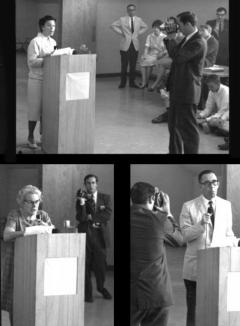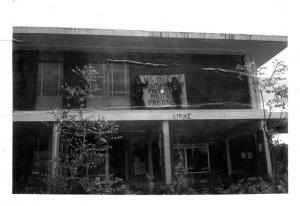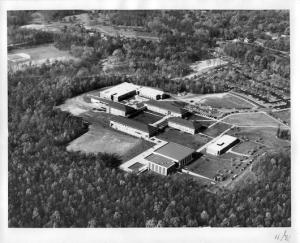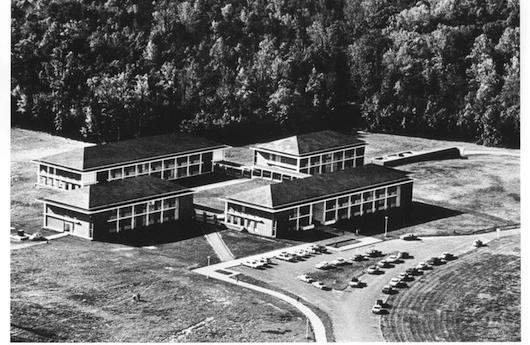The story behind Mason's founding: the college's uneasy beginning
The following piece is the third of a four-part series on the history of George Mason University. The information and research in this article is based off of “George Mason University: A History,” a project created by University Libraries’ Special Collections & Archives department. The first part of the series is available here. The second is available here.
After a contentious and divisive battle over the location of the University of Virginia’s new branch college, George Mason College was geared to serve the higher education needs of Northern Virginia.
With the site selected, the college would experience growth and challenges after its opening in 1964. The student body and faculty would stage a protest against college leadership, the college would become a four-year institution and today’s traditions would be set before the university became independent in 1972.
George Mason College’s uneasy beginning
In December 1963, John Norville Gibson Finley, an early advocate of Northern Virginia higher education and director of the University’s Northern Virginia Center, retired.
Robert H. Reid, a history professor at NVUC, was promoted as the first director of George Mason College, and was tasked with building and growing the foundations of the institution, and leading it to a four-year institution.
“It is a fulfillment of Thomas Jefferson’s dream that a college has come to Northern Virginia,” Reid said at the dedication of the new campus on Nov. 12, 1964. “This is the first major breakthrough in higher education for the Washington metropolitan area in 50 years.”
The Fairfax campus officially opened on Sept. 14, 1964 with a total of 356 registered students, and seven full and 18 part-time instructors.
Despite the positive start of Reid’s tenure, six faculty members resigned in protest of his administration within eight months. As director, Reid was responsible for guiding the new institution in its formative years, though with little administrative support. Reid filled the positions of dean of college, dean of students, director of admissions and business manager. Additional administrative staff would not join George Mason College until 1965.
Many faculty members said that Reid was discourteous, a poor communicator and an ineffective administrator. Some even accused him of misrepresenting his employment and academic credentials when being recruited by UVa.
In February of 1965, Reid instituted a dress code for all students of the university in face of student outrage. Faculty was instructed to ask any students not adhering to new requirements to leave the classroom..
On May 19, the faculty passed a vote of no confidence on Reid’s administration 21 to 1.
According to that week’s issue of “The Gunston Ledger”, the bi-monthly student newspaper, faculty expressed frustration with working with administration, citing lack of cooperation on establishing academic programs, filling key administrative openings and refusing to “confirm the reappointment of at least five faculty members.”
“A spokesman for the ‘dissident faculty’ said that more resignations are expected to follow as soon as it becomes certain that Dr. Reid will be retained,” read the 1965 article.
 |
| Faculty stage a strike against Reid's administration (photo courtesy of George Mason University Libraries). |
On May 21, Reid met with students to discuss their concerns, but denied two requests to “hold the faculty resignations for reconsideration, or to “resign to insure that [George Mason College] would have a ‘first rate faculty’ next year,” read the issue of the “Gunston Ledger”.
In a letter dated May 20, 1965, U.Va. President Edgar Shannon wrote “that the university is continuing its careful inquiry to determine the facts underlying recent complaints and will take whatever action may be required to advance the interests of the college while protecting the rights of individuals.”
In March 1966, Reid resigned as director of the college, citing reluctance among state officials in granting Mason’s independence from the University of Virginia.
Shortly after Reid’s departure, Shannon chose Lorin A. Thompson for replacement. Thompson, who served as Director of the Bureau of Population and Economic Research in Charlottesville and was an expert in demographics and education, seemed suitable for the job.
Although he accepted the position, he only agreed to a one-year appointment due to his age of 64. Despite the agreement, Thompson would go on to serve an additional six years as the newly titled Chancellor of George Mason College, guiding the university through years of growth and eventually independence in 1972.
By the end of Thompson’s tenure as chancellor, the Fairfax campus grew from 150 to nearly 600 acres, increased enrollment from 840 to 4,200 and completed 10 newly constructed buildings on campus, including Fenwick Library and Lecture Hall.
The college attains four-year status
While controversy plagued the first years of George Mason College, UVa and Northern Virginia officials were planning for the next stage of the institution – shifting from a two-year community college, to a four-year degree-granting college.
George Mason College, with less than 600 enrolled students, made some progress in addressing higher educational needs in the area. However, many lamented that there was still more to be done to address the rapidly growing youth population; UVa and other Virginia officials were well-aware of the additional needs.
In 1965, Virginia’s Higher Education Study Commission released a study recommending the establishment of four-year colleges in Northern Virginia and the Tidewater region. That same study also recommended that George Mason College become independent of UVa.
Later, in 1966, Alexandria delegate James M. Thompson, with the backing of UVa, introduced a bill that would turn Mason into a four-year degree-granting institution. The bill easily passed in the Virginia General Assembly, and was signed into law on March 1.
Student unrest in the 60’s
In the 1960’s, Mason’s campus experienced the similar political and cultural upheaval that was prevalent in colleges across the nation. At Mason, the Vietnam War and racial tensions pitted students against the administration. Many of the conflicts of the decade were spurred by the college’s student newspaper, “The Gunston Ledger”.
 |
| Students protest US involvement in Southeast Asia (photo courtesy of George Mason University Libraries). |
Founded in 1963, “The Ledger” initially provided measured information on campus events in its monthly publication. As many of the issues of the 60’s began to take hold on campus, the newspaper’s staff began to take on more personality and opinion. In the fall of 1967, the newspaper’s staff began reporting about social issues that campuses were highlighting across the nation, including the Vietnam War, poverty, racism and academic freedom.
In October of 1969, “The Ledger” was renamed to “Broadside”, as it is known today. In a letter to its readers, the Broadside staff explained that “broadsides,” were documents used for “poetical effusions, news items and political propaganda,” during the American Revolution.
“The George Mason College Newspaper staff has decided that the title of our publication no longer represents the things which we want it to stand for,” read the first publication of the newspaper under the new title. “We feel that in these important times the name BROADSIDE not only symbolizes the effort on our part to reach the students with the news, but also continues the tie with the history of this country that our school maintains.”
Preparing for growth and independence
When George Mason College was first established in 1957, it served a mere 17 students. By 1985, Mason was expected to serve 15,000.
 |
| After the becoming a four-year institution, George Mason College would expand rapidy (photo courtesy of George Mason University Libraries). |
In 1966, George Mason College’s Board of Control enlisted the Northern Virginia Regional Planning and Economic Development Council to study the infrastructure needs of the university to address growing demand. The report made several recommendations on how and where to build classrooms, studying spaces and other amenities. The recommendations provided the initial framework for how much of the Fairfax campus looks today.
“The expansion of George Mason College to a four-year facility will provide direct benefit to all the jurisdictions in this area much beyond the immediate effect of providing an education for our youth.” wrote John Lohman, chairman of the economic development commission.
The reported ended with two sentences: “EXPAND THE CAMPUS TO 600 ACRES TODAY! THE LAND WILL NOT BE VACANT TOMORROW!”
As investments began in the future of George Mason College, university officials from both Fairfax and Charlottesville were preparing for independence of the institution in 1972.
The fourth part of the series will outline the steps leading up to George Mason College’s independence from the University of Virginia.

